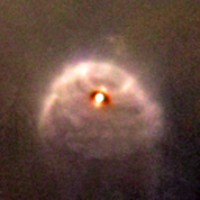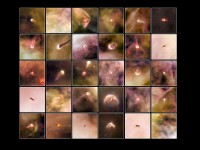The Hubble Space Telescope photographed an atlas of 42 preplanetary nebulae illuminated by one of the strongest stars in the Orion Nebula, 30 of which were imaged for the first time

A collection of 30 never-before-seen images of embryonic solar systems in the Orion Nebula are the result of the Hubble Space Telescope's longest single project dedicated to star and planet formation. The bubbly protoplanetary disks surrounding newly formed stars shed light on the mechanisms responsible for planet formation.
The Orion Nebula, which looks like a magnificent watercolor painting, is the most photographed object in space and one of the favorite targets of the Hubble Space Telescope. Newly born stars emerge from the mixture of gas and dust, and the pre-planetary disks are formed along with them. The center of the spinning disc heats up and becomes a new star, but the debris around it attracts other dust particles and clumps together. Preplanetary disks are thus solar systems in the process of formation. In an ambitious survey of the familiar nebula, in which the Advanced Camera for Surveys was used, the researchers discovered 42 preplanetary disks.
The Orion Nebula, which is also visible, has been known since ancient times, but was first described at the beginning of the 17th century by the French astronomer Nicolas-Claude Fabry de Pierresque, who received the credit for its discovery. The nebula, which lies 1,500 light-years away and is also known as M42, is the closest star-forming region to Earth, and contains stars massive enough to heat the gas surrounding them, allowing them to shine in colors and make the region look like every stargazer's dream.

The researchers discovered two types of disks that surround young and developing stars: those that are close to the bright star in the cluster (Theta 1 Orionis C) and those that are far from it. This bright star heats the gas in the neighboring disks and causes them to glow brightly. The more distant disks do not receive enough radiation from the star to heat the gas and you can only discover them as dark silhouettes against the background of the bright nebula, because the gas surrounding these disks absorbs the background radiation in visible light. By studying these silhouettes, astronomers can better characterize the properties of the gas grains that stick together and possibly form planets like ours.
The bright disks can be distinguished by glowing edges of the excitation material and facing towards the bright star, but we see this as a random trend within the nebula so some of them are visible on the side, some of them are facing us. Other interesting features are material jets and shock waves. Shock waves are created when the solar wind from neighboring large stars collides with the gas in the nebula, forming boomerang or arrow-like formations, or in the case of 181-825 - a space jellyfish.
It is very rare to see visible light images of protoplanetary nebulae, but the high resolution and sensitivity of the Hubble and the proximity of the Orion Nebula to Earth allows us to accurately observe potential solar systems.
The Atlas of Preplanetary Nebulae is the first scientific result from the Orion program of the Hubble Space Telescope. Unique programs of this type are carried out to allow scientists to carry out extensive research over long periods because the time for expansion at the Hubble Space Telescope is tightly timed.
High-resolution images of preplanetary disks are an example of a scientific discovery that led to better technology and is one of the main scientific tasks for the Atacama Large Millimeter/submillimeter Array (ALMA) observatory - one of the largest ground-based observatories to be built in the next decade. Alma will allow observing dust at longer wavelengths, in emissions (and not in absorption of light as we see in the optical wavelengths), and in an angular spread 10 times better than Hubble's. However, only the Hubble Space Telescope with its high resolution and sensitivity can take such detailed images of the circumstellar disks at the wavelengths of visible light.

4 תגובות
And don't be nerdy enough to comment on me writing a stick instead of a keyboard,
Thanks.
Israel, don't fiddle with the stick please!
Avi Blizovsky
Someone missing here gets boring.
And to think that they wanted to disable the Hubble telescope several years ago.